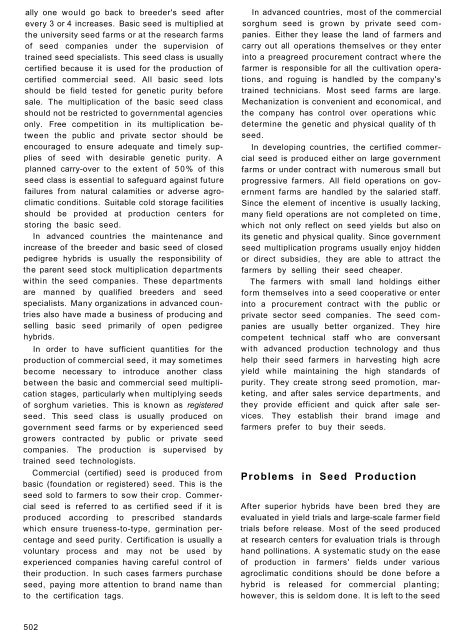RA 00048.pdf - OAR@ICRISAT
RA 00048.pdf - OAR@ICRISAT
RA 00048.pdf - OAR@ICRISAT
Create successful ePaper yourself
Turn your PDF publications into a flip-book with our unique Google optimized e-Paper software.
ally one would go back to breeder's seed after<br />
every 3 or 4 increases. Basic seed is multiplied at<br />
the university seed farms or at the research farms<br />
of seed companies under the supervision of<br />
trained seed specialists. This seed class is usually<br />
certified because it is used for the production of<br />
certified commercial seed. All basic seed lots<br />
should be field tested for genetic purity before<br />
sale. The multiplication of the basic seed class<br />
should not be restricted to governmental agencies<br />
only. Free competition in its multiplication between<br />
the public and private sector should be<br />
encouraged to ensure adequate and timely supplies<br />
of seed with desirable genetic purity. A<br />
planned carry-over to the extent of 50% of this<br />
seed class is essential to safeguard against future<br />
failures from natural calamities or adverse agroclimatic<br />
conditions. Suitable cold storage facilities<br />
should be provided at production centers for<br />
storing the basic seed.<br />
In advanced countries the maintenance and<br />
increase of the breeder and basic seed of closed<br />
pedigree hybrids is usually the responsibility of<br />
the parent seed stock multiplication departments<br />
within the seed companies. These departments<br />
are manned by qualified breeders and seed<br />
specialists. Many organizations in advanced countries<br />
also have made a business of producing and<br />
selling basic seed primarily of open pedigree<br />
hybrids.<br />
In order to have sufficient quantities for the<br />
production of commercial seed, it may sometimes<br />
become necessary to introduce another class<br />
between the basic and commercial seed multiplication<br />
stages, particularly when multiplying seeds<br />
of sorghum varieties. This is known as registered<br />
seed. This seed class is usually produced on<br />
government seed farms or by experienced seed<br />
growers contracted by public or private seed<br />
companies. The production is supervised by<br />
trained seed technologists.<br />
Commercial (certified) seed is produced from<br />
basic (foundation or registered) seed. This is the<br />
seed sold to farmers to sow their crop. Commercial<br />
seed is referred to as certified seed if it is<br />
produced according to prescribed standards<br />
which ensure trueness-to-type, germination percentage<br />
and seed purity. Certification is usually a<br />
voluntary process and may not be used by<br />
experienced companies having careful control of<br />
their production. In such cases farmers purchase<br />
seed, paying more attention to brand name than<br />
to the certification tags.<br />
In advanced countries, most of the commercial<br />
sorghum seed is grown by private seed companies.<br />
Either they lease the land of farmers and<br />
carry out all operations themselves or they enter<br />
into a preagreed procurement contract where the<br />
farmer is responsible for all the cultivation operations,<br />
and roguing is handled by the company's<br />
trained technicians. Most seed farms are large.<br />
Mechanization is convenient and economical, and<br />
the company has control over operations whic<br />
determine the genetic and physical quality of th<br />
seed.<br />
In developing countries, the certified commercial<br />
seed is produced either on large government<br />
farms or under contract with numerous small but<br />
progressive farmers. All field operations on government<br />
farms are handled by the salaried staff.<br />
Since the element of incentive is usually lacking,<br />
many field operations are not completed on time,<br />
which not only reflect on seed yields but also on<br />
its genetic and physical quality. Since government<br />
seed multiplication programs usually enjoy hidden<br />
or direct subsidies, they are able to attract the<br />
farmers by selling their seed cheaper.<br />
The farmers with small land holdings either<br />
form themselves into a seed cooperative or enter<br />
into a procurement contract with the public or<br />
private sector seed companies. The seed companies<br />
are usually better organized. They hire<br />
competent technical staff who are conversant<br />
with advanced production technology and thus<br />
help their seed farmers in harvesting high acre<br />
yield while maintaining the high standards of<br />
purity. They create strong seed promotion, marketing,<br />
and after sales service departments, and<br />
they provide efficient and quick after sale services.<br />
They establish their brand image and<br />
farmers prefer to buy their seeds.<br />
Problems in Seed Production<br />
After superior hybrids have been bred they are<br />
evaluated in yield trials and large-scale farmer field<br />
trials before release. Most of the seed produced<br />
at research centers for evaluation trials is through<br />
hand pollinations. A systematic study on the ease<br />
of production in farmers' fields under various<br />
agroclimatic conditions should be done before a<br />
hybrid is released for commercial planting;<br />
however, this is seldom done. It is left to the seed<br />
502

















